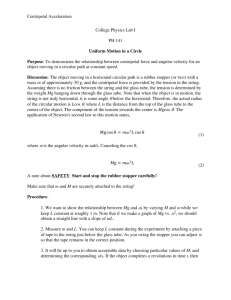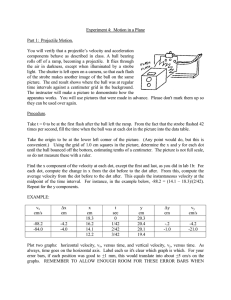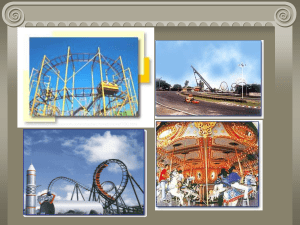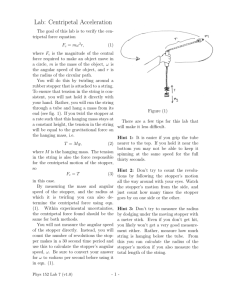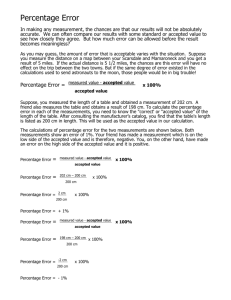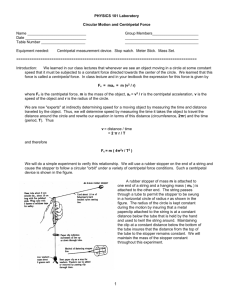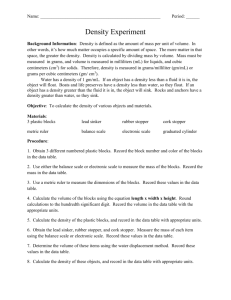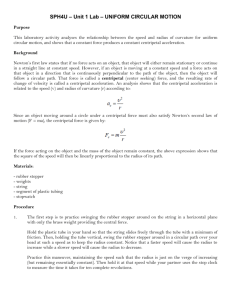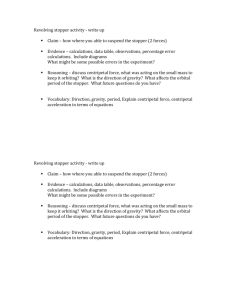WHIRLIGIG – Experiment with Centripetal Force Learning Objectives
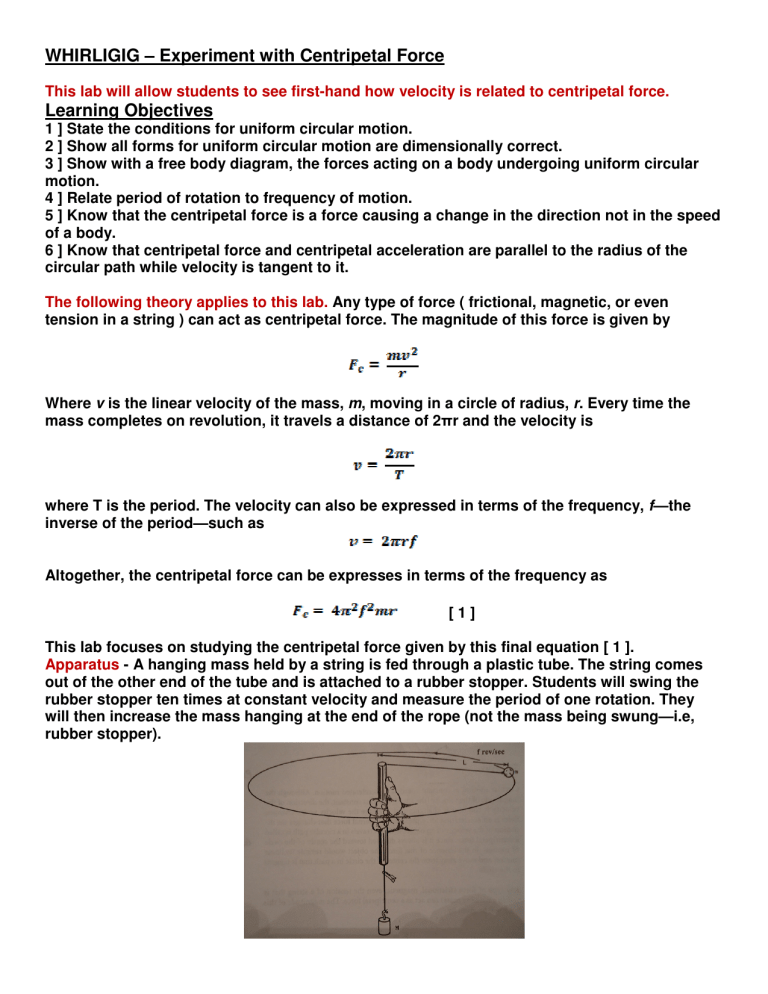
WHIRLIGIG – Experiment with Centripetal Force
This lab will allow students to see first-hand how velocity is related to centripetal force.
Learning Objectives
1 ] State the conditions for uniform circular motion.
2 ] Show all forms for uniform circular motion are dimensionally correct.
3 ] Show with a free body diagram, the forces acting on a body undergoing uniform circular motion.
4 ] Relate period of rotation to frequency of motion.
5 ] Know that the centripetal force is a force causing a change in the direction not in the speed of a body.
6 ] Know that centripetal force and centripetal acceleration are parallel to the radius of the circular path while velocity is tangent to it.
The following theory applies to this lab.
Any type of force ( frictional, magnetic, or even tension in a string ) can act as centripetal force. The magnitude of this force is given by
Where v is the linear velocity of the mass, m , moving in a circle of radius, r . Every time the mass completes on revolution, it travels a distance of 2 π r and the velocity is where T is the period. The velocity can also be expressed in terms of the frequency, f —the inverse of the period—such as
Altogether, the centripetal force can be expresses in terms of the frequency as
[ 1 ]
This lab focuses on studying the centripetal force given by this final equation [ 1 ].
Apparatus - A hanging mass held by a string is fed through a plastic tube. The string comes out of the other end of the tube and is attached to a rubber stopper. Students will swing the rubber stopper ten times at constant velocity and measure the period of one rotation. They will then increase the mass hanging at the end of the rope (not the mass being swung—i.e, rubber stopper).
You will notice that as you whirl the racket ball around, the part of the string from the tube to the racket ball is not quite horizontal. Gravity acting on the stopper pulls it down.
By looking at the figures below, we can understand the combined effects of gravity and centripetal force on the stopper. This is a side-view of the apparatus shown above.
The distance, r , is the distance from the center of gravity of the stopper to the axis of rotation
(i.e, rubber tube). θ is the angle between r and the string. L is the actual length of the string
(between center of mass of stopper and center of tube ). Note that r / L = cos θ .
It can also be seen that the force exerted by the string on the stopper has two components, F g and F c
. F g
is the force necessary to balance the weight W (mg) so that there is no vertical motion. Since = W, there is no net motion in the vertical direction. F c
is the force required to keep the stopper moving in a circular path (directed towards the axis of rotation). Thus, note that F c
/ F string
= cos θ . Rearranging this relationship and inserting our expression for F c
gives
If the relationship r / L = cos θ is now utilized, the equation above becomes
The force or tension on the string is provided by the weight of the hooked mass, Mg. Thus which becomes
Again, m is the mass of the rubber stopper being swung in a circle.
Procedure
1 ] Start with a 100 g mass for m ( add it to loop of string holding stopper ). Whirl the stopper over your head while holding on to the string hanging below the tube. Practice spinning the stopper over your head while maintaining the path of the stopper completely horizontal, until you can let go of the string and maintain the same motion. Then increase the speed of the stopper. EACH LAB PARTNER SHOULD DO THIS. WEAR SAFETY GOGGLES.
2 ] To officially begin, allow for the string ( start from the center of the tube and measure to the center of gravity of the stopper ) to be 50 cm; this is L . Attach an alligator clip to the string about 1 cm ( ∆ L ) below the tube. This will serve as a marker so you can keep the radius constant while whirling the ball. Measure and record L and ∆ L to one decimal place accuracy in cm.
3 ] Once L
1
is determined, hang a 100 gm hooked mass, M
1
, at the end of the string. Now swing the ball over your head maintaining a constant speed and radius ( the clip should be motionless ). While doing this, your lab partner will measure the time it takes the ball to swing through a fixed number ( such as 30 ) revolutions. Subtract to obtain the total time. Repeat this a second time. If your second TOTAL time differs from your first TOTAL time by more than 2 seconds, you must repeat the proceure until you obtain two time estimates that difer by no more than 2 seconds.
4 ] Now place a hooked mass, M
2
, at the end of the string that is less than 100 gm and more than 50 gm . Without changing the length, L , or the position of the clip, repeat step 3. Record
M
2
and the total times.
5 ] Now place a hooked mass, M
3
, at the end of the string that is less more 100 gm and less than 300 gm at the end of the string . Without changing the length, L , or the position of the clip, repeat step 3. Record M
3
and the total times.
6 ] Now change the length, L , so that is between 30 and 50 cm. Measure and record L
4
to one decimal place in cm. Place a 100 gm hooked mass, M
4
, at the end of the string. Repeat step 3.
7 ] Finally, change the length, L , so that it is between 50 and 70 cm. Measure and record L
5
to one decimal place in cm, Place a 100 gm hooked mass, M
5
, at the end of the string. Repeat step 3.
8 ] Determine the mass, m, of the stopper. THIS COULD BE DONE FIRST .
